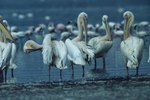
The Philippines are rich in history and culture, and only about one-third of its islands are inhabited by people. Its tropical forests harbor hundreds of species of mammals and birds. However, logging and development has many species either vulnerable or endangered -- included the world’s largest eagle.
The Philippine Eagle
Critically endangered Philippine eagles are the largest eagle in the world with a wingspan up to 7 feet, and a natural life span between 30 and 60 years. Male and females are brown with cream underbellies. Long feathers around their head and neck give them a disheveled crest, and pairs produce one egg per year. Their common name is the monkey-eating eagle, and as it suggests monkeys, as well as flying lemurs, rats, snakes and the like are their prey. They are native to the Philippines and were once widespread across its larger islands. It is now believed their individual number is less than 250.
The White-Bellied Sea Eagle
Another large and majestic bird is the white-bellied sea eagle. Their undersides are white, as well as their head and neck. Backs and wings are gray, and their wings are black tipped. They are mainly a coastal bird that primarily feeds on fish, sea snakes and turtles, but they can be found inland around bodies of water, and will feed on domestic livestock. Pairs are monogamous for life, and typically produce two eggs per year. Although their numbers are declining, their habitat is widespread, and they are not listed as vulnerable on the International Union for Conservation of Nature red list.
The Philippine Serpent Eagle
Philippine serpent eagles are medium-size raptors that average 20 inches in length, and have a wingspan ranging between 3 to 4 feet. They are brown with white spotting, and their legs and masks are yellow. As their name dictates, they feed mainly on snakes and lizards. They live on two of the larger islands of the Philippines, and adults tend to stay within their territory once their range has been established. Although threatened by habitat loss, they tend to adapt to changes in their environment and remain common within their territories.
The Brahminy Kite
Brahminy kites are known by a variety of names, including the Singapore bald eagle. Their underbellies, head and neck are white, while their back and wings are chestnut brown. These birds are often more scavengers than hunters, and their diet varies within different populations. They hunt crustaceans, small reptiles, mammals and fish. They also feed off the waste from boats, and are common at harbors or other fish processing sites. They also will steal the prey from other raptors, and since they will raid prawn farms, they are problematic in some areas.
References
Photo Credits
-
Comstock/Comstock/Getty Images
Writer Bio
Slone Wayking worked as a professional in the veterinary field for 20 years. Though her interest in animal health led to this path, Wayking initially studied creative arts. She has been article writing for more than a year and is currently working towards her degree in multimedia. Her certifications include business writing and basic web design.



